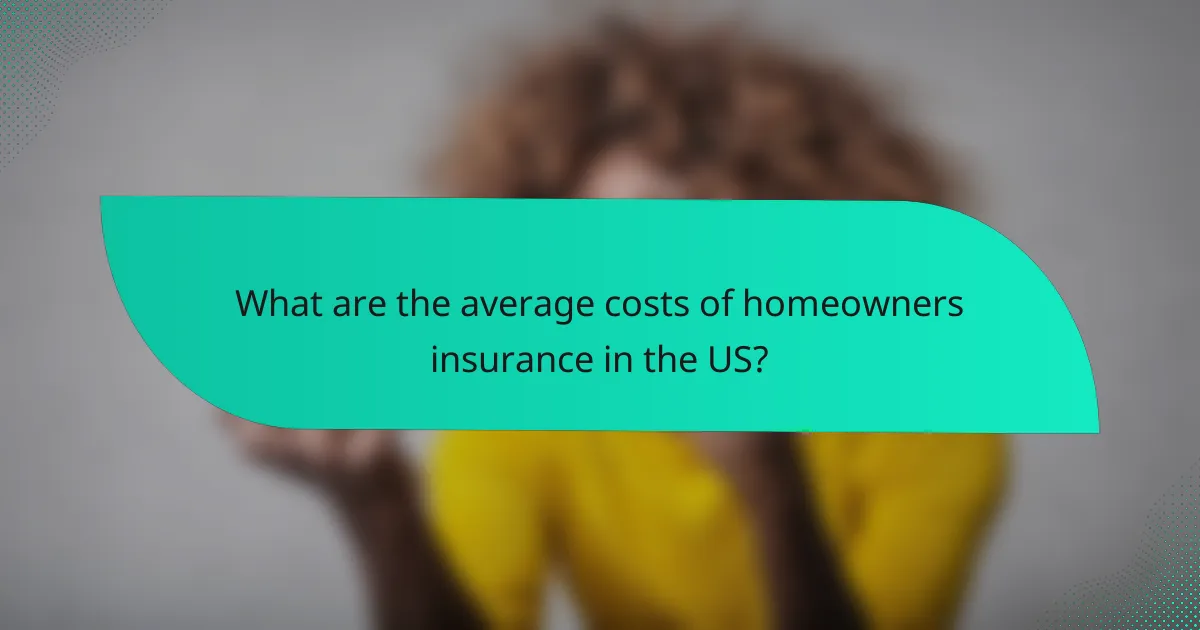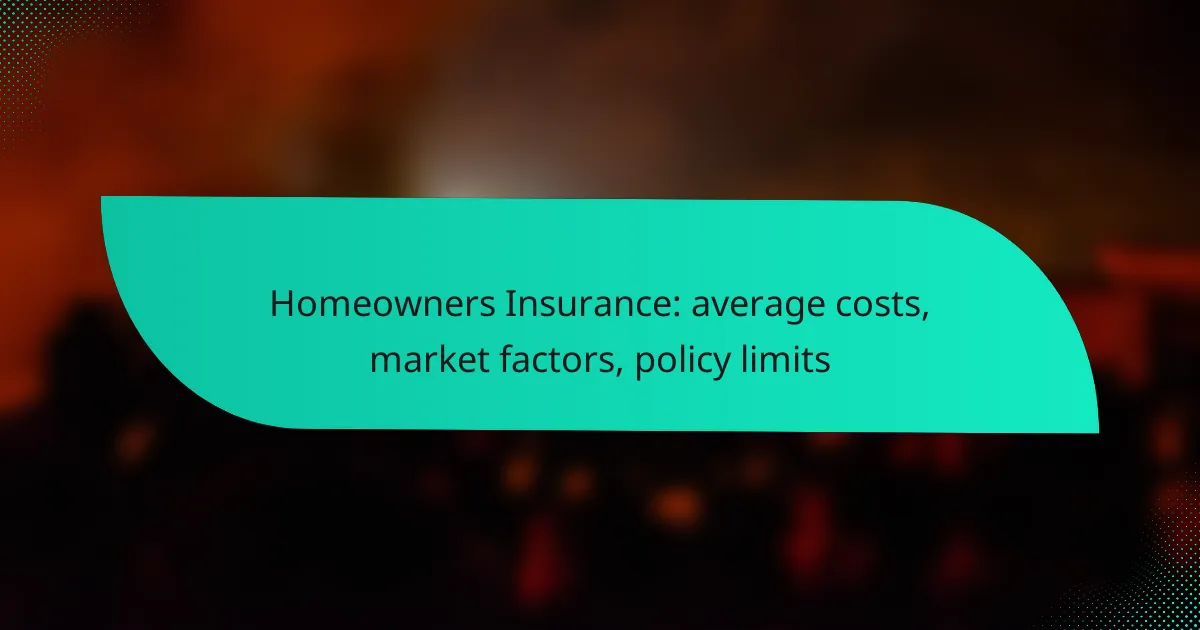Homeowners insurance is an essential aspect of protecting your property, with average annual costs typically ranging from the low hundreds to low thousands of dollars. Various factors, including local market conditions and risk assessments, play a significant role in determining these premiums. Additionally, policy limits can vary widely, generally starting at $100,000 and extending to several million, making it vital for homeowners to select coverage that aligns with their needs and the value of their home.

What are the average costs of homeowners insurance in the US?
The average cost of homeowners insurance in the United States typically ranges from low hundreds to low thousands of dollars annually, depending on various factors. Homeowners should consider these costs as part of their overall homeownership expenses, factoring in coverage limits and local market conditions.
National average premium
The national average premium for homeowners insurance is generally around $1,200 to $1,500 per year. This figure can vary significantly based on the type of coverage, the value of the home, and the insurer’s pricing strategy. Homeowners should shop around to find competitive rates that meet their coverage needs.
Cost variations by state
Factors influencing premiums
Several key factors influence homeowners insurance premiums, including the home’s location, age, and construction type. Homes in high-risk areas for floods or earthquakes typically incur higher costs. Additionally, the homeowner’s credit score and claims history can also affect premiums, with better scores often leading to lower rates.
Homeowners should regularly review their policies and consider increasing deductibles or bundling insurance products to potentially lower their premiums. It’s also wise to assess the coverage limits to ensure they align with the current market value of the home and its contents.

How do market factors affect homeowners insurance rates?
Market factors significantly influence homeowners insurance rates by determining the level of risk insurers face. Elements such as natural disasters, economic conditions, and supply chain issues can lead to fluctuations in premiums, affecting how much homeowners pay for coverage.
Impact of natural disasters
Natural disasters like hurricanes, floods, and wildfires can dramatically increase homeowners insurance rates. Insurers assess the likelihood of these events in specific areas, leading to higher premiums in regions prone to such risks. For example, homes located in flood zones may see premiums rise by 20% or more compared to those in safer areas.
Homeowners can mitigate costs by investing in disaster-resistant features or maintaining a good claims history. Additionally, some regions may offer discounts for properties equipped with storm shutters or other protective measures.
Economic conditions and inflation
Economic conditions, including inflation, directly impact homeowners insurance rates. As the cost of materials and labor rises, insurers may adjust premiums to reflect these increased expenses. Homeowners could see annual rate increases in the range of 5% to 10% during periods of high inflation.
To manage costs, homeowners should regularly review their policies and shop around for competitive rates. Understanding the economic landscape can help in negotiating better terms or finding more affordable options.
Supply chain issues in construction
Supply chain disruptions in the construction industry can lead to higher repair and rebuilding costs, which in turn affect homeowners insurance rates. When materials are scarce or delayed, insurers may raise premiums to cover potential losses. This can result in increases of around 10% or more if supply issues persist.
Homeowners can prepare by ensuring their homes are well-maintained and by considering policies that offer guaranteed replacement cost coverage. Staying informed about local construction trends can also help homeowners anticipate changes in their insurance costs.

What are typical policy limits for homeowners insurance?
Typical policy limits for homeowners insurance generally range from $100,000 to several million dollars, depending on the value of the home and the coverage needs of the homeowner. These limits determine the maximum amount the insurance company will pay for covered losses, making it crucial to choose limits that adequately protect your property and assets.
Standard coverage limits
Standard homeowners insurance policies often include coverage for the dwelling, personal property, liability, and additional living expenses. Common dwelling coverage limits start around $100,000, but many homeowners opt for limits that reflect the full replacement cost of their home, which can easily exceed $300,000 in many areas.
Personal property coverage typically ranges from 50% to 70% of the dwelling limit. Liability coverage usually starts at $100,000, but higher limits are advisable to protect against potential lawsuits.
Variations based on property value
The value of your property significantly influences your policy limits. Homes in urban areas or regions with higher real estate prices may require much higher coverage limits compared to homes in rural locations. For example, a home valued at $500,000 may need a dwelling limit of $500,000 or more to ensure full protection.
Additionally, factors such as local building costs, the age of the home, and unique features can affect the necessary policy limits. Homeowners should regularly reassess their coverage to ensure it aligns with current market values.
Optional add-ons and endorsements
Homeowners can enhance their policies with optional add-ons and endorsements to cover specific risks or increase limits. Common endorsements include increased personal property coverage, scheduled personal property for high-value items, and additional liability protection.
These add-ons can be beneficial, especially for homeowners with valuable possessions or those living in areas prone to natural disasters. It’s essential to evaluate these options carefully and consider their costs versus the potential benefits to ensure adequate protection.

How can homeowners reduce their insurance costs?
Homeowners can reduce their insurance costs through several strategies that lower premiums while maintaining adequate coverage. Key methods include increasing deductibles, bundling policies, and implementing safety measures in the home.
Increasing deductibles
Raising your deductible is one effective way to lower your homeowners insurance premium. A higher deductible means you will pay more out-of-pocket in the event of a claim, but it can significantly reduce your monthly or annual costs. For example, increasing your deductible from $500 to $1,000 might save you around 10-20% on your premium.
Before making this decision, consider your financial situation and whether you can comfortably afford the higher deductible in case of a loss. It’s a balancing act between immediate savings and potential future expenses.
Bundling policies with providers
Bundling your homeowners insurance with other policies, such as auto or life insurance, can lead to substantial discounts. Many insurance companies offer incentives for customers who choose multiple policies, often resulting in savings of 5-25%. This approach not only simplifies your insurance management but also enhances your overall savings.
When considering bundling, compare the total costs and coverage options of different providers. Ensure that the bundled policies meet your needs and that you are not sacrificing coverage for the sake of a discount.
Implementing home safety measures
Improving the safety of your home can lead to lower insurance premiums. Installing security systems, smoke detectors, and deadbolt locks can reduce the risk of theft and damage, prompting insurers to offer discounts. Some companies may provide savings of up to 10-15% for homes equipped with advanced safety features.
Additionally, consider regular maintenance and upgrades, such as updating electrical systems or plumbing, to minimize risks. Documenting these improvements can help you negotiate better rates with your insurer.

What are the prerequisites for choosing a homeowners insurance policy?
Choosing a homeowners insurance policy requires understanding your property’s value, your specific coverage needs, and the available insurance providers. These factors will help you select a policy that adequately protects your home and belongings while fitting your budget.
Assessing property value
To choose the right homeowners insurance, start by accurately assessing your property’s value. This includes considering the current market value of your home, any renovations or improvements made, and the cost to rebuild in case of a total loss.
Utilize online valuation tools or consult with real estate professionals to get a clearer picture. Generally, homeowners should ensure their coverage limit is equal to or slightly above the estimated replacement cost to avoid being underinsured.
Understanding coverage needs
Next, evaluate your coverage needs based on your lifestyle and possessions. Standard homeowners insurance typically covers the structure, personal belongings, liability, and additional living expenses, but you may need extra coverage for high-value items or specific risks like flooding or earthquakes.
Consider creating an inventory of your belongings and their estimated values to determine the appropriate coverage limits. This will help you avoid gaps in protection and ensure you are adequately covered in case of a claim.
Researching insurance providers
Finally, research various insurance providers to find the best policy for your needs. Look for companies with strong financial stability, positive customer reviews, and good claims handling records. Comparing quotes from multiple insurers can help you find competitive rates.
Pay attention to the policy details, including deductibles, coverage limits, and exclusions. It’s advisable to read the fine print and ask questions to clarify any uncertainties before making a decision.

What are common exclusions in homeowners insurance policies?
Common exclusions in homeowners insurance policies include specific natural disasters, maintenance issues, and certain personal liabilities. Understanding these exclusions is crucial for homeowners to ensure they have adequate coverage and to avoid unexpected out-of-pocket expenses.
Flood and earthquake coverage
Most standard homeowners insurance policies do not cover flood or earthquake damage. Homeowners in areas prone to these events often need to purchase separate flood insurance through the National Flood Insurance Program (NFIP) or earthquake insurance from private insurers. The cost of these additional policies can vary significantly based on location and risk factors.
For example, flood insurance premiums can range from a few hundred to several thousand dollars annually, depending on the property’s flood zone designation. Earthquake insurance may also be costly, especially in regions like California, where seismic activity is common.
Wear and tear limitations
Homeowners insurance typically excludes coverage for damage resulting from normal wear and tear. This means that issues like aging roofs, peeling paint, or outdated plumbing systems are generally not covered. Homeowners should regularly maintain their properties to prevent such issues from escalating into larger, more costly repairs.
It’s advisable to conduct annual inspections and address maintenance needs promptly. Keeping documentation of repairs and upgrades can also be beneficial when filing claims for covered damages, as insurers may scrutinize the condition of the home before approving claims.
